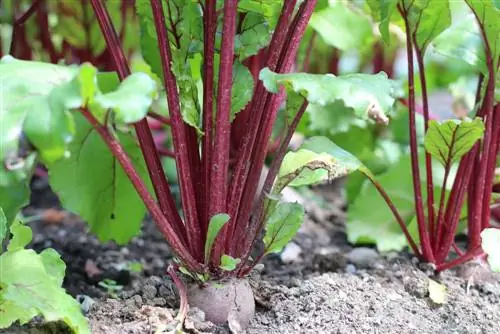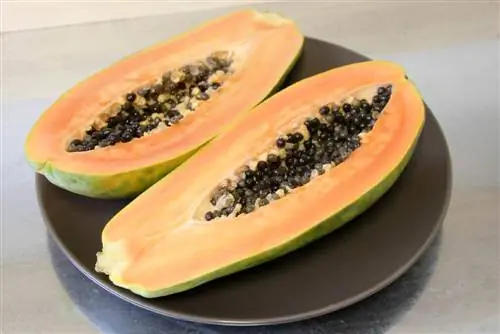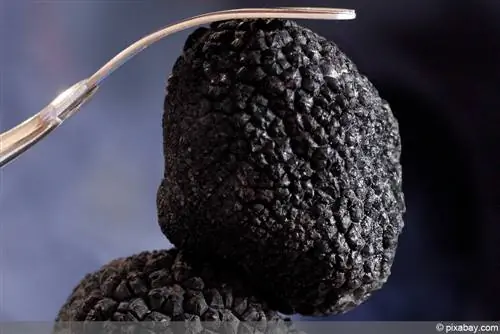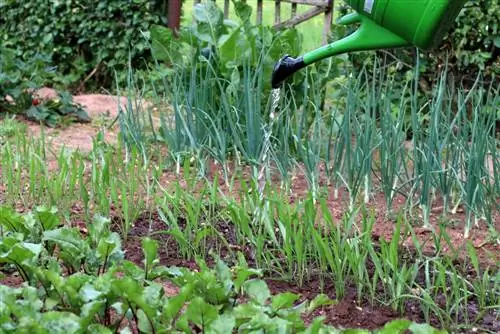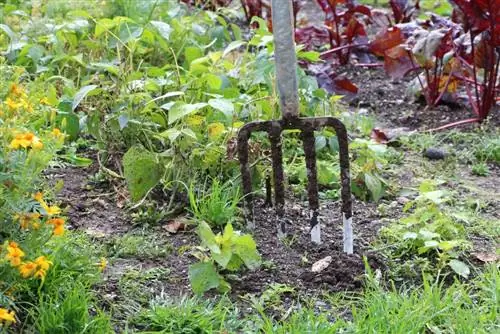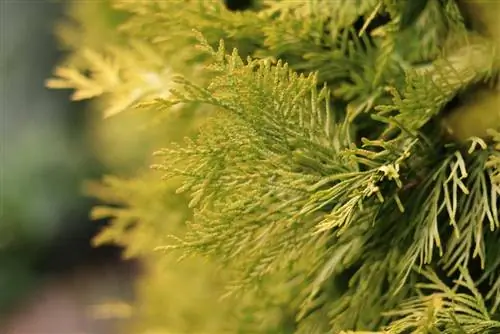- Author admin [email protected].
- Public 2023-12-17 03:39.
- Last modified 2025-01-24 12:45.
The types of winter vegetables that can be harvested even in frosty temperatures include salsify, leeks, parsnips and many types of cabbage. Admittedly, you have to do a little research about it in advance and gardening should be more fun than hardship. But the effort is rewarded. At the latest when a delicious stew with home-grown vegetables is on the table on a cold winter day. Below is a look at the winter vegetables and their special needs in the bed.
Cultivation
Most winter vegetables are sown or planted from March to July. Some even later, like winter purslane and winter cress. If you have little space in the garden or want it to be manageable and comfortable, you should create a raised bed.
In addition to the appropriate time for sowing or planting, it is important to know which vegetables should not be planted in the immediate vicinity. There are early and late varieties of many vegetables, for example onions and lamb's lettuce.
Care
Winter vegetables are considered relatively easy to care for. Nevertheless, they should not be overgrown by weeds and should be provided with sufficient compost. The watering depends on the weather and whether the vegetables are shallow or deep-rooted. As far as possible, vegetables should always be watered with rainwater or at least with stale water.
Harvest
There are winter vegetables that are harvested in late autumn at the latest, before the first frost and there are frost-hardy winter vegetables.
The frost-hardy vegetables include:
- Kale
- Parsnips
- Turnips
- Jerusalem Jerusalem artichoke
- Black salsify (harvest in late autumn, but can also tolerate frost)
- Lamb lettuce (light protection)
- Winter cress (light protection)
A late harvest, before the frost period, but ideal as a winter supply:
- Beetroot
- Pak Choi
- Chinese cabbage
- Spinach
- Winter squash
- Winter onions
- Winter garlic
Winter vegetables
Kale (Brassica oleracea var. sabellica L.)
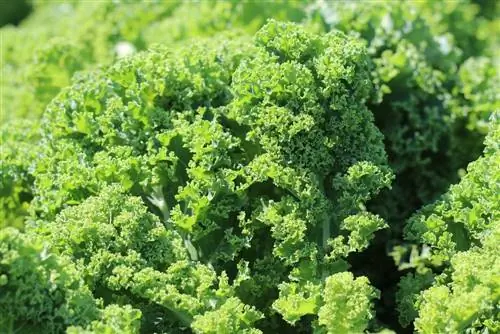
Kale is a frost-hardy classic. It even needs the frost, only then does it bloom, from a culinary point of view. Kale grows like a palm tree, its curly leaves are attached to the stem and it can reach a height of up to one meter. The gray-green leaves can easily be plucked from the stem as needed. It is best to grow kale from seeds and plant it in the bed from July, or at the latest in August. Kale is a heavy feeder, so it needs nutrient-rich soil. However, a thorough addition of compost every year is completely sufficient.
- can be grown well with wellery, it repels harmful cabbage white butterflies
- Herbs (caraway & coriander) in the same bed flavor it
Lam's lettuce (Valerianella)
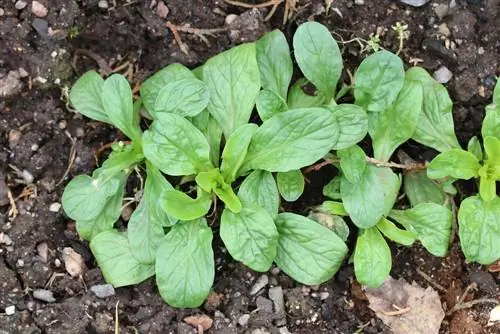
Lamb lettuce is the ultimate winter salad. It can be sown widely from mid-August until October. Of course, clear row planting is also possible. For later sowing, choose a winter-hardy variety. The leaves are smaller and the growth is slightly stocky. Lamb's lettuce, or Rapunzel, is undemanding and does not require further fertilization. It doesn't have any special soil requirements either.
- Location should be bright and sunny
- The soil must under no circumstances dry out for the first three weeks after sowing
- Harvest is best done in the evening or early in the morning in frost-free weather
- good neighbors are strawberries and radishes
Winter purslane (Claytonia perfoliata)
Winter purslane, also known as postelein or plate herb, is a he althy addition to winter salads. It is a so-called cold germinator, which means that it germinates even at soil temperatures below 12 degrees. The winter purslane can still be sown at the beginning of September. After just two months, the spinach-like leaves can be harvested throughout the winter.
- When harvesting, leave about five centimeters standing so that it can sprout again
- is a weak feeder and has hardly any soil requirements
- likes moist soil and grows in shade or partial shade
- Rocket, radish and strawberries good neighbors
Parsnip (Pastinaca sativa)
The parsnip is becoming increasingly popular again in German kitchens. The white, long taproots are often confused with root parsley. However, in terms of taste they are far apart. A little frost at the beginning of winter doesn't hurt it, on the contrary, it gets a milder taste. The seeds are sown in March and April on nutrient-rich and loose soil. A deep, loamy, sandy soil is ideal. The main growing season for the roots is September.
- Harvest time is in October
- Unwashed, the roots can be stored for a long time; it is best to store them in a cool, dark basement room
- A container with moist sand is ideal
- some cultivars are very frost hardy and can even remain in the ground until next year
- good partners in the bed are onions, lettuces and radishes
- mixing the compost immediately before sowing is sufficient to provide nutrients until harvest
Beetroot (Beta vulgaris)
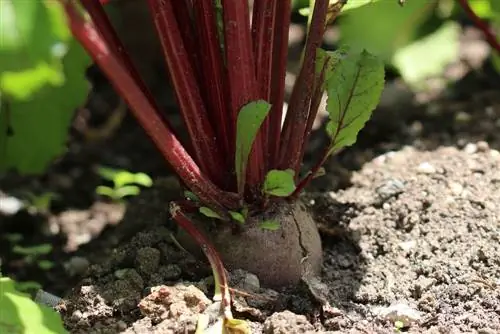
The beetroot must be out of the ground before the first frost. But the late varieties can be stored well into winter. They are sown in June. The soil should be humus-rich and loose. Continuous moisture until harvest is important for the deep-rooted tubers to mature. If the soil is rich in nutrients, it is sufficient to fertilize once during the growing season as soon as the first tubers form. Nettle or comfrey manure with rock powder is a good mixture for a natural nutritional replenishment.
- Harvest after three to four months after sowing
- Can be stored for a long time in a box with moist sand at one to four degrees
- good bed neighbors are: onions, cabbage, lettuce, dill and savory
Parsley root (Petroselinum crispum)
The root parsley, parsley root or parsley bulb takes a long time until its creamy white, often irregularly growing roots can be harvested. Sowing is best done in March or April. Sowing later will result in smaller roots in the fall. The soil should first be thoroughly loosened and mixed with compost. The parsley root likes it to be warm, sunny and not too humid all year round. It is difficult for it to prevail against weeds, so the bed must be kept as free of weeds as possible.
- Beetroot and spinach are good neighbors
- from October you can harvest them all winter long
- You can harvest greens that taste similar to parsley in the summer
- but you shouldn't overdo it because it weakens the development of the roots
Celeriac (Apium graveolens)
The celeriac must be harvested before winter, but if stored well it can still be available in winter. It is best to grow it early so that the plants can be planted outdoors after the Ice Saints. Celery is a heavy feeder, so the soil should be generously enriched with compost beforehand. As it continues to grow, it generally needs moist soil. You can fertilize from time to time with nettle manure. If you want light-colored tubers, you can start by watering them a few times with a light s alt solution. When a small tuber has formed, stimulate tuber growth by removing a little of the soil at the top so that some of the tuber sticks out of the ground.
- Let grow until October, then harvest
- Unwashed tubers can be stored for a long time in a dry and cool (basement) room
- goes well with cabbage, leeks and spinach
Note
Be careful when watering with s alt solution, it is only compatible with celery!
Wintercress (Barbarea vulgaris)
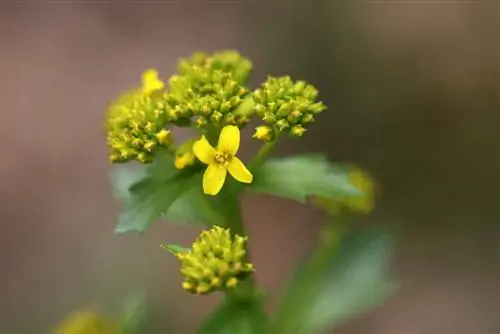
Like all types of cress, winter cress, which contains vitamin C, is easy to cultivate because it is very undemanding. It produces crisp, dark green, spicy, slightly spicy leaves in a rosette. Barbara herb, as it is also called, is frost hardy. Winter cress can be sown until September. About 10 weeks later it is harvest time. The soil should be nutrient-rich and moist when sowing. In the further course it is enough to water enough and keep the area free of weeds.
- do not use extra fertilizer
- is two years old
- Seeds itself regularly
- good bed neighbors are strawberries and lamb's lettuce
Jerusalem artichoke (Helianthus tuberosus)
A sunflower with tuberous, brown, potato-like roots, that is the Jerusalem artichoke. Cultivating Jerusalem artichokes in the garden is extremely easy and requires very little maintenance. Similar to potatoes, plant tubers are planted in spring. Everything else is almost regulated by nature. The only thing is: Jerusalem artichokes love it sunny, but they also need enough water. They can be placed along a property line. The bright yellow flowers grow up to two meters high and can form a beautiful privacy screen.
- You can't miss the harvest time
- when the herb withers, the first tubers are ready for harvest
- can remain in the ground until consumed
- or until they sprout again next spring
Tip:
Attention, the Jerusalem artichoke tends to overgrow and spreads a lot if it is not checked.
Black salsify (Scorzonera)
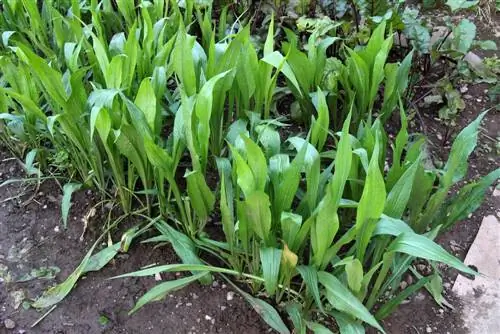
Black salsify or winter asparagus are a yellow-flowering, attractive addition to any vegetable patch. They are sown directly outdoors in March and April. It is not advisable to prefer them as the small plants are very sensitive. Just like the seeds, they are elongated and can break easily. You need deep, loose soil that is as stone-free as possible. Every now and then, organic fertilizer, regular watering and weeding are all required in order to be able to enjoy these tasty roots from autumn onwards.
- grow very slowly, six months to maturity
- They can be harvested from October and then throughout the winter because they are frost hardy
- good neighbors in the bed are cabbage, salads and onions
Tip:
Of course, the harvest is done on a frost-free day, because the long roots break easily and have to be carefully removed from the ground with a digging fork.
Turnips (Brassica napus subsp. rapifera)
Like parsnips, turnips were banned from the menu for a long time and have been experiencing a renaissance in German kitchens for some time. Tasty varieties and their winter hardiness make them a popular winter vegetable. They can be harvested as needed from October onwards. From June they will be sown directly outdoors, but then they still have to be separated.
- requires approx. 40 cm of space all around
- Medium feeder - does not require large amounts of fertilizer
- additional water is only required in longer dry periods
- Harvest season starts in September
- hardy tubers can then be taken fresh from the ground as needed
- Frost also gives the turnips a slight sweetness in the taste.
Brussels sprouts (Brassica oleracea var. gemmifera)
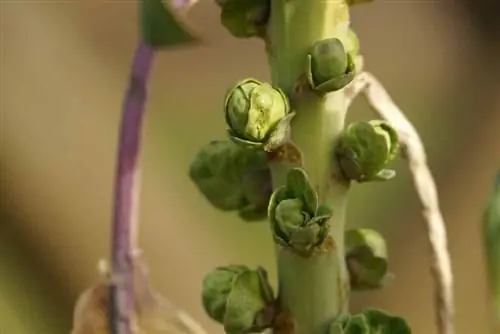
Similar to kale, Brussels sprouts are also a classic winter vegetable that are not harvested until November. Even if the first frosts are beneficial to its taste, it must not be exposed to strong, persistent frosts for a long time, otherwise the florets will become soft. From mid-April and May you can sow it directly outdoors. The soil should be improved with compost and horn shavings beforehand. In summer you can mulch the bed so that the soil does not dry out so quickly. Now the Brussels sprouts have already reached their final height and may need to be supported
- If you cut off the tip, you prevent further florets from growing and the power can go into the existing florets
- harvesting is always from bottom to top
- To store them longer after harvesting, we recommend blanching and freezing them
Growing Tips
If you don't have enough space in your garden to grow vegetables, you can create a raised bed. In addition to its size and manageability, a raised bed offers other advantages:
- a comfortable height for gardening and harvesting
- the ground is warmer
- earlier sowing possible
- nutrient-rich soil
Conclusion
When it comes to winter vegetables, there are some varieties that are extremely easy to care for and even beginners can grow them almost on the side or simply let them grow. Not all winter vegetables are frost hardy, like Jerusalem artichokes or turnips. Brussels sprouts and beetroot cannot be harvested fresh all winter long, but must be harvested early and stored adequately. Depending on whether they are weak or heavy feeders and whether they have deep or shallow roots, it is important to adapt the fertilizer and water doses to the corresponding needs. Beds with vigorously growing vegetables (Jerusalem artichokes) do not need to be cleared of weeds as carefully throughout the year as areas where the more delicate representatives (parsley root, salsify) grow.

